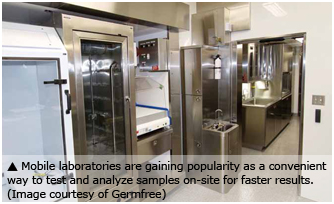INSIGHTS
In a sense, a detector — handheld, mobile or stationary
— is the frontline tool within a network of CBRN
detection, analysis and identification instruments.
Detectors provide information either as a single tool or
as part of a network of tools that will contribute to the
work in mobile and fixed-site laboratories by correctly
classifying and identifying the threat materials. “When
entering an area or a building suspected of CBRN
activities, a handheld detector is useful in that it gives
warnings and location of the substance in question,”
Heyl said. “Detailed and confirmed identification of
a substance in question can be determined later in a
laboratory setting — mobile, modular or fixed — for
further analysis.”
Scouting Hidden Danger:CBRN Detectors on the Frontline of Public Safety Ⅱ
Date: 2011/02/16
Source: a&s International
Field testing protocols for CBRN detectors still need time to mature. “Since there is limited real-life experience with using the detectors in the field, it is hard for users to understand the strengths and weaknesses of a certain detector, and therefore difficult to adapt to or improve existing protocols,” Gaasbeek said. Customers should understand the full potential of the instruments procured and check if the instruments are working as they should be.
A solution to this problem is third-party laboratory tests, replacing on-site trials. An airport cannot come by nuclear weapons just to test equipment sensitivity, which risks the lives of innocent bystanders. “Normally a demonstration of device capabilities is a test report from an external research laboratory,” Anttalainen explained. “Quite often, customers conduct their own tests during the purchasing process in their national laboratories and also field tests by end users."
Facilities for detection testing are restricted to special areas, as users cannot readily test live CWA or radioactive materials in public or environmentally sensitive locations. Users can also use CBRN detection simulators for training. “Increasing numbers of detectors designed around a range of different technologies are procured to meet specific operational parameters, and to provide cross-confirmatory assurance requirements,” said John Saunders, Sales and Marketing Manager of Argon Electronics. “This has led to a requirement to deliver a multi-instrumented training capability that is not easily achieved using real detectors, but which can be provided by integrated simulation systems.” Simulator instruments have been procured as a cost-effective alternative to real and expensive detectors for training purposes.
 Existing technologies will ripen for the CBRN industry, driven by market demand. Long-term R&D efforts will continue for further maturation of existing products, allowing even higher sensitivity levels and accuracy rates. Specialized detection technology will be adopted in the civilian world for better and faster diagnostic precision, particular in health care. “In the U.S., industry works closely with government, and together they keep technology on the cutting edge while supporting those at risk. For instance, the U.S. has been able to transition battlefield medical technologies into the practical sciences that directly apply to industry and commerce,” Heyl said. “Another trend is the way forward with robotic developments. Robots that have been developed specifically for battlefield applications are now transitioned back home for improved industrial and medical use.” As the world stands on tip toes for public assaults and dangers, CBRN detectors help keep watch for uninvited threats at all times.
Existing technologies will ripen for the CBRN industry, driven by market demand. Long-term R&D efforts will continue for further maturation of existing products, allowing even higher sensitivity levels and accuracy rates. Specialized detection technology will be adopted in the civilian world for better and faster diagnostic precision, particular in health care. “In the U.S., industry works closely with government, and together they keep technology on the cutting edge while supporting those at risk. For instance, the U.S. has been able to transition battlefield medical technologies into the practical sciences that directly apply to industry and commerce,” Heyl said. “Another trend is the way forward with robotic developments. Robots that have been developed specifically for battlefield applications are now transitioned back home for improved industrial and medical use.” As the world stands on tip toes for public assaults and dangers, CBRN detectors help keep watch for uninvited threats at all times.